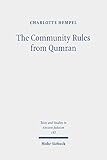The community rules from Qumran : a commentary / Charlotte Hempel.
Material type: TextSeries: Texte und Studien zum antiken Judentum ; 183.Publication details: Tübingen : Mohr Siebeck, 2020.Description: 1 online resource (xxiv, 346 pages)Content type:
TextSeries: Texte und Studien zum antiken Judentum ; 183.Publication details: Tübingen : Mohr Siebeck, 2020.Description: 1 online resource (xxiv, 346 pages)Content type: - 9783161570278
- 3161570278
- 290
- BM488.M3 H46 2020eb
- online - EBSCO
| Item type | Current library | Call number | URL | Status | Notes | Barcode | |
|---|---|---|---|---|---|---|---|
 eBook
eBook
|
Biblioteca "Angelicum" Pont. Univ. S.Tommaso d'Aquino Nuvola online | online - EBSCO (Browse shelf(Opens below)) | Online access | Not for loan (Accesso limitato) | Accesso per gli utenti autorizzati / Access for authorized users | (ebsco)2628780 |
Description based upon print version of record.
Includes bibliographical references (pages 301-322) and indexes.
General introduction -- Introduction: outline of communal aspirations -- Admission into and reaffirmation of the covenant -- The teaching on the two spirits -- Requirements and leadership for a new community in two founding narratives -- Rules concerning meetings -- The penal code -- The council of the community -- Deliberate failure to obey a commandment -- Rules of conduct and discipline for the people of perfect holiness -- The community and the cultic realm -- The authority of the sons of Aaron -- The conduct of the people of holiness and the people of deceit -- The statutes for the maskil -- Hymn.
In this volume, Charlotte Hempel offers the first comprehensive commentary on all twelve ancient manuscripts of the Rules of the Community, works which contain the most important descriptions of the organisation and values ascribed to the movement associated with the Dead Sea Scrolls. The best preserved copy of this work (1QS) was one of the first scrolls to be published and has long dominated the scholarly assessment of the Rules. The approach adopted in this commentary is to capture the distinctive nature of each of the manuscripts based on a synoptic translation that presents all the manuscripts at a glance. Textual notes and Commentary deal with the picture derived from all preserved manuscripts. The publication of the Cave 4 manuscripts in 1998 can be likened to a volcanic eruption that challenged prevalent notions of the Community Rules that were founded on the quasi-archetypal status of the Cave 1 copy published in 1951. Since then the smoke has lifted and, as the pieces have begun to settle, we see green shoots emerging in the scholarly debate. This commentary embraces the post-volcanic landscape of the Community Rules, which is carefully sifted for clues to establish a fresh reading of the material in conversation with the latest research on the Scrolls. The evidence suggests that some of the practices described as the beating heart of the movement's organization reflect the aspirations of a privileged sub-elite from the late Second Temple Period.


